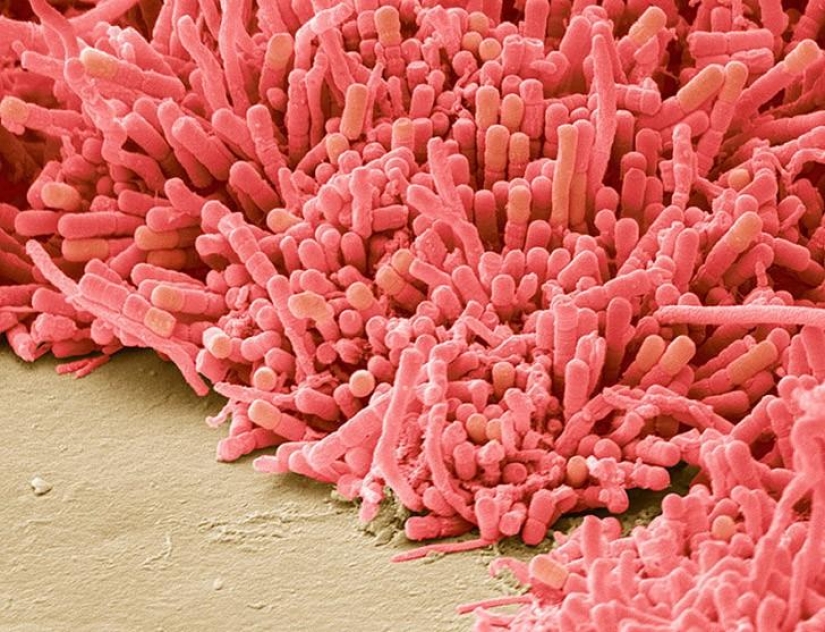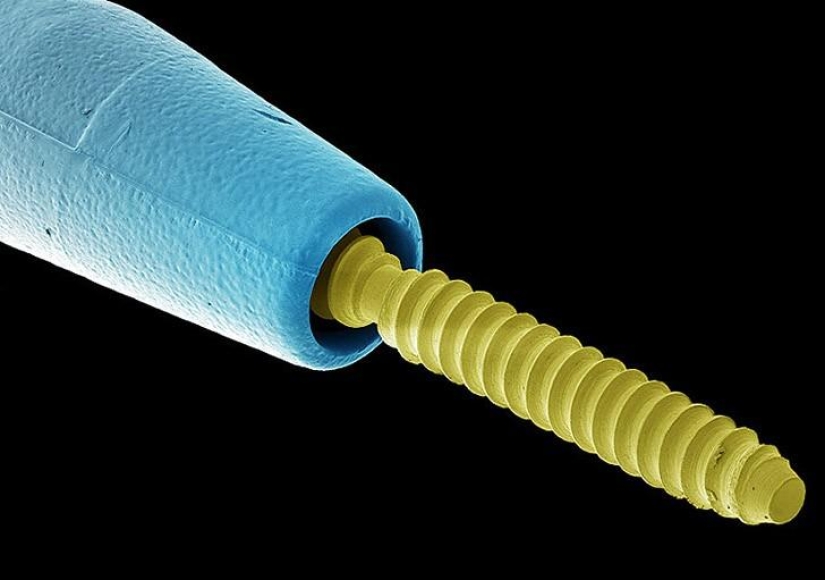What's in your mouth, close-up
Categories: Health and Medicine | Microworld
By Pictolic https://pictolic.com/article/what39s-in-your-mouth-close-up.htmlWhat you see in these photos may look like rare plants or exotic landscapes, but in fact it's... bacteria that nestles on your teeth, as well as other microorganisms that live on your gums or on your toothbrush.

These macrophotographs were taken using a microscope, which scans the sample with a focused beam of electrons. The photographs were then digitally or hand-colored so that individual elements could be distinguished. These photographs belong to the Scientific Photography Laboratory in London and are used for research and educational purposes. They clearly show us the consequences of poor oral hygiene.
 Dental plaque (400x magnification, 10 cm width) is a biofilm formed by colonizing bacteria that try to attach to the tooth surface. (SPL/Barcroft Media)
Dental plaque (400x magnification, 10 cm width) is a biofilm formed by colonizing bacteria that try to attach to the tooth surface. (SPL/Barcroft Media)
 And this is the same plaque at 10,000 times magnification. The width remains unchanged. (SPL/Barcroft Media)
And this is the same plaque at 10,000 times magnification. The width remains unchanged. (SPL/Barcroft Media)
 Baby tooth. Most human teeth are made of dentin, a substance that lines the cavity that contains soft connective tissue, blood vessels, and nerves. The crown of the tooth is then covered by enamel (white in the photo above), a stronger and more mineralized substance that protects dentin from acids in the mouth. At the root of a tooth, dentin is protected by a substance called cementum (pink), which serves as a means by which the periodontal ligaments can attach to the tooth for stability. (SPL/Barcroft Media)
Baby tooth. Most human teeth are made of dentin, a substance that lines the cavity that contains soft connective tissue, blood vessels, and nerves. The crown of the tooth is then covered by enamel (white in the photo above), a stronger and more mineralized substance that protects dentin from acids in the mouth. At the root of a tooth, dentin is protected by a substance called cementum (pink), which serves as a means by which the periodontal ligaments can attach to the tooth for stability. (SPL/Barcroft Media)
 Shown here are the enamel-forming cell layer (blue), tooth surface (yellow), and dentin (red). Loss of enamel or cementum exposes dentin, a porous substance with microscopic channels called dentinal tubules that connect the pulp, resulting in tooth sensitivity. (SPL/Barcroft Media)
Shown here are the enamel-forming cell layer (blue), tooth surface (yellow), and dentin (red). Loss of enamel or cementum exposes dentin, a porous substance with microscopic channels called dentinal tubules that connect the pulp, resulting in tooth sensitivity. (SPL/Barcroft Media)
 (SPL/Barcroft Media)
(SPL/Barcroft Media)
 Yellow shows plaque on the surface of the tooth. Acid is a waste product produced during the digestive process of bacteria. It demineralizes the tooth, creating cavities that need to be filled or can lead to tooth loss. (SPL/Barcroft Media)
Yellow shows plaque on the surface of the tooth. Acid is a waste product produced during the digestive process of bacteria. It demineralizes the tooth, creating cavities that need to be filled or can lead to tooth loss. (SPL/Barcroft Media)
 A human incisor with a hollow or loss of minerals caused by acidic bacterial debris. In this case, the decay has formed on the side of the tooth (between two teeth) and at the gum line (between the crown - the yellow one - and the root), perhaps due to a lack of flossing or improper flossing. British scientists found that every third adult is susceptible to caries, and a study conducted on 5-year-old children in 2012 showed that every 4th of them has some degree of caries. (SPL/Barcroft Media)
A human incisor with a hollow or loss of minerals caused by acidic bacterial debris. In this case, the decay has formed on the side of the tooth (between two teeth) and at the gum line (between the crown - the yellow one - and the root), perhaps due to a lack of flossing or improper flossing. British scientists found that every third adult is susceptible to caries, and a study conducted on 5-year-old children in 2012 showed that every 4th of them has some degree of caries. (SPL/Barcroft Media)
 We hope this photo convinces you to floss your teeth every day... The yellow is bacteria on your gums. Plaque buildup can lead to gum disease such as gingivitis or periodontitis. (SPL/Barcroft Media)
We hope this photo convinces you to floss your teeth every day... The yellow is bacteria on your gums. Plaque buildup can lead to gum disease such as gingivitis or periodontitis. (SPL/Barcroft Media)
 The surface of a human tooth (colored yellow), a carpet of spherical bacteria (colored blue), and blood vessels (colored red). (SPL/Barcroft Media)
The surface of a human tooth (colored yellow), a carpet of spherical bacteria (colored blue), and blood vessels (colored red). (SPL/Barcroft Media)
 Toothbrush bristles. They wear down and wear out over time, reducing the effectiveness of your toothbrush. You need to change your toothbrush at least every 3-4 months. However, wear may vary from person to person depending on their brushing habits. If necessary, you should change your toothbrush earlier. (SPL/Barcroft Media)
Toothbrush bristles. They wear down and wear out over time, reducing the effectiveness of your toothbrush. You need to change your toothbrush at least every 3-4 months. However, wear may vary from person to person depending on their brushing habits. If necessary, you should change your toothbrush earlier. (SPL/Barcroft Media)
 Toothbrush bristles covered with plaque. After brushing your teeth, you should rinse your toothbrush thoroughly to remove any remaining toothpaste or particles of plaque and bacteria. It should dry while standing in the open air. Closed containers contain more moisture, which promotes the development of microorganisms. (SPL/Barcroft Media)
Toothbrush bristles covered with plaque. After brushing your teeth, you should rinse your toothbrush thoroughly to remove any remaining toothpaste or particles of plaque and bacteria. It should dry while standing in the open air. Closed containers contain more moisture, which promotes the development of microorganisms. (SPL/Barcroft Media)
 Plaque on the bristles of a used toothbrush at 750x magnification. (SPL/Barcroft Media)
Plaque on the bristles of a used toothbrush at 750x magnification. (SPL/Barcroft Media)
 Interdental brushes (as in the photo) have small heads with bristles designed to clean the spaces between teeth. Your dentist may advise you to use an interdental brush, but it is not a substitute for dental floss. (SPL/Barcroft Media)
Interdental brushes (as in the photo) have small heads with bristles designed to clean the spaces between teeth. Your dentist may advise you to use an interdental brush, but it is not a substitute for dental floss. (SPL/Barcroft Media)
 A more detailed view of the bristles of a used interdental brush covered with plaque. (SPL/Barcroft Media)
A more detailed view of the bristles of a used interdental brush covered with plaque. (SPL/Barcroft Media)
 Crown of a baby tooth. Its root has become separated through a process known as temporary tooth resorption. This was caused by pressure from the growing permanent tooth. (SPL/Barcroft Media)
Crown of a baby tooth. Its root has become separated through a process known as temporary tooth resorption. This was caused by pressure from the growing permanent tooth. (SPL/Barcroft Media)
 Plaque-forming bacteria at 1000x magnification. (SPL/Barcroft Media)
Plaque-forming bacteria at 1000x magnification. (SPL/Barcroft Media)
 Bacteria that form plaque. (SPL/Barcroft Media)
Bacteria that form plaque. (SPL/Barcroft Media)
 Plaque-forming bacteria at 8,000x magnification. (SPL/Barcroft Media)
Plaque-forming bacteria at 8,000x magnification. (SPL/Barcroft Media)
 Among other uses, drills (pictured) are also used to remove soft tissue and bacteria from plaque in preparation for a filling, otherwise new plaque may begin to form under the filling. (SPL/Barcroft Media)
Among other uses, drills (pictured) are also used to remove soft tissue and bacteria from plaque in preparation for a filling, otherwise new plaque may begin to form under the filling. (SPL/Barcroft Media)
 This is the tip of the drill. (SPL/Barcroft Media)
This is the tip of the drill. (SPL/Barcroft Media)
 Calcium phosphate crystals used to remineralize a tooth after mineral loss due to bacteria. (SPL/Barcroft Media)
Calcium phosphate crystals used to remineralize a tooth after mineral loss due to bacteria. (SPL/Barcroft Media)
 A dental post used to strengthen filling and crown material when a large portion of a tooth is decayed or missing. (SPL/Barcroft Media)
A dental post used to strengthen filling and crown material when a large portion of a tooth is decayed or missing. (SPL/Barcroft Media)
Recent articles

Illustrator from Canada Mark Gagne (Mark Gagne) presented a series of works called "Ink Photography" (Inked Photography). If you ...

Someone thinks that perfectionism is a disease that should be treated. Someone, on the contrary, teaches others how to restore ...

Although body positivity is actively promoted to the masses these days, slim figures remain trendy. Even those who demonstrate ...